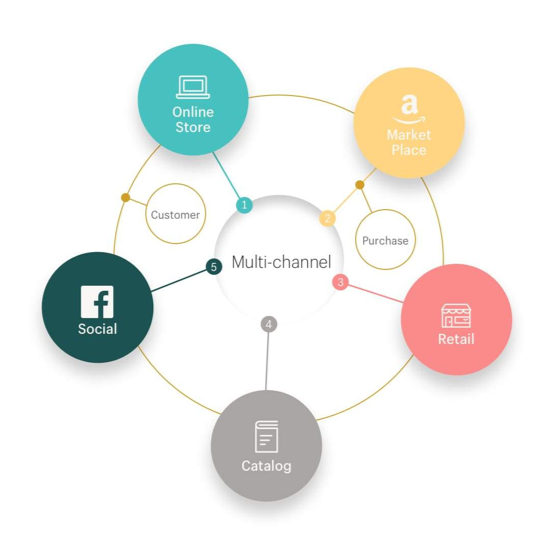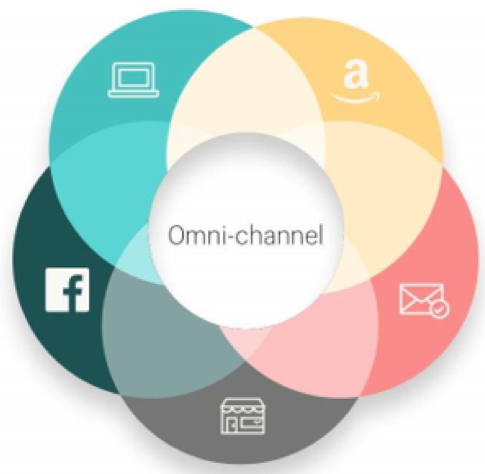Marketing managers have a lot of options in for marketing tactics, which can make creating a cohesive marketing strategy difficult. Where should a company’s limited number of advertising dollars go? Should a marketing plan focus on web ads, email, mobile, social media, direct mail, print media, radio, TV, or pay-per-click? The answer is yes—all of them.
With so many advertising outlets available, and with target audiences possibly fragmented among several types of media, the most effective approach is multi-channel marketing.
Multi-channel marketing engages customers across several direct and indirect communication channels. The average person divides their time between social media, searching Google, reading emails, watching YouTube, and getting their news and shopping online. Marketers must be several places at once because customers are several places at once.
Statistics show that it takes five to seven impressions before someone will remember your brand. Companies today can’t afford to advertise in one medium in the hopes that customers will come to them. A company needs to be in multiple places so that a customer will get brand exposure from a Facebook ad, Google ad, banner ad, email ad, online video, radio ad, or print ad.
Multi-channel marketing is not just an attempt to keep your brand in front of customers’ eyes. According to Referral SaaSquatch, “Being available via a customer’s chosen channel directly aligns your brand with higher levels of engagement and conversions.” And it’s not only more engagement and more conversions, but analytics experts say that multi-channel customers also spend three to four times more than single-channel customers do.
Does multi-channel marketing mean that it’s necessary to spend the company’s pension fund on one ad campaign so that your brand can be everywhere? Of course not. But to know how to best spend those advertising dollars, there are some steps that marketers must take in deciding which channels will be the most effective.
Know Your Customer
To effectively target a specific audience, it’s crucial to know everything about that audience. Who is your customer? Where do they live? How old are they? How much money do they make? Does your customer spend time on social media or watching TV?
If you sell denture adhesive, and your target audience is 75-year-old retirees, Snapchat ads may not be a smart use of your advertising budget. But, with 62% of those over 65 being regular Facebook users, a Facebook ad would be a better spend.
The point is, it’s important to have a clear picture of your customer, know which media they spend time on, and advertise to that exact same customer on every platform.
Consolidate Resources
Once you know on which media your customer spends time, there must be a consistency in your message across all platforms. You can’t create emails in-house and hire freelancers to handle social media because your message will become fragmented. The best way to achieve a unified message in all media platforms is to hire an agency to coordinate advertising to various channels.
An agency will be certain that a radio ad, TV spot, social media post, email blast, and banner ad all share the exact same message.
Integrate All Channels
Once you know your customer and you’ve created a clear message for all the various media you plan on using, it’s time to get all those media working together without replicating your content. Your Facebook ad could link to your Instagram account, which has your website in the bio. A print ad could incorporate hashtags to help customers move from print to online media. E-blasts should link to the company website or social media page.
Some media pair more naturally, so it’s easy to integrate them, as the following pairs from a MediaPost report show:
- Computer/mobile
- TV/mobile
- Computer/TV
- Radio/mobile
- Computer/radio
Move Toward Omni-Channel Marketing
By executing the step of integrating all channels, you move from multi-channel marketing to omni-channel marketing, which is a little more complicated, but a lot more effective.
Shopify has presented two graphics that clearly display the difference between the two marketing strategies.
The first graphic represents multi-channel marketing. Each channel offers the customer a separate opportunity to purchase, and while the message to the various channels is consistent, each channel is distinct and unrelated to the others:

Shopify’s second graphic shows how, in omni-channel marketing, all the channels are connected and overlap:

The example Shopify uses is this:
- A customer visits the website of company XYZ, puts an item in their cart, and leaves.
- The customer soon receives an email with a $100 off incentive.
- Over the next week, a $100 off coupon appears to the customer on Facebook, Instagram, and YouTube.
- After a week of non-engagement, the customer begins seeing ads highlighting XYZ’s socially conscious activities with links to its Giving Back page.
- When the customer visits YouTube, they see a pre-roll that features a video of XYZ’s participation in a socially conscious organization that helps a local underserved community.
- The customer returns to the website of XYZ, where they watch another video, look at other products, but again leaves without making a purchase.
- Social media sites now present the customer with a $150 off coupon.
- The customer then receives a print offer through the U.S. mail, inviting them to XYZ’s brick-and-mortar store.
- The customer visits the store, finally makes a purchase, and immediately receives a thank-you email.
In multi-channel marketing, customers are given separate but equal purchase opportunities in various media. The purchase opportunities are not related to each other, but all share a similar message. The consistency of multi-channel marketing is very effective.
In omni-channel marketing, all media are engaged and working together, with escalating purchase opportunities. The related engagement of an omni-channel marketing strategy is even more effective than multi-channel and can continue with different tactics and proliferating offers until the customer finally makes a purchase. However, it requires more resources and, to be effective, it must continue until the customer finally buys.
Both multi-channel and omni-channel marketing takes an extremely coordinated strategy to work. The advertising professionals at McFadden/Gavender can create a multi- or omni-channel marketing plan designed specifically for your business. Contact us and we’ll show you how!

